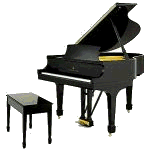

Composers from Amazon.com's Get Started in Classical:
| Bach | Glass | Schubert |
| Beethoven | Mahler | Stravinsky |
| Copland | Mozart | Tilson Thomas |
| Corigliano | Mutter | Wagner |
| Debussy | Pärt | Zimerman |
| NEW! Huang Additional composers and musicians |
||
Ludwig van Beethoven
This is from Amazon.com's Get Started in Classical.
Beethoven used the piano, the instrument with which he particularly identified, to chart a new course for music.
When he was an ambitious young man just coming of age, Beethoven relocated in 1792 from provincial Bonn to the musical capital of Vienna. There the musician made his first indelible impressions as a pianist of blazing originality in the salons of the aristocracy. Beethoven's ability to wield a profoundly hypnotic spell through his powers of improvisation at the keyboard, along the way frequently snapping strings and splintering hammers, was the topic of many a contemporary diary. The instrument seemed an extension of his personality--even after the point where Beethoven's increasing deafness made it impossible to play in public--and the composer used it as a medium to communicate his visionary individualism. The cycle of 32 sonatas he composed remains the bible of any serious pianist's repertory. These works, as with Beethoven's series of string quartets, constitute an intimate portrait of the artist's development. They illustrate, with their refinements of the past and mind-expanding innovations, the great Beethoven paradox: that music so intensely personal can affect its listeners with such universal resonance and inevitability.
The legendary performances here gather together three of the most famous sonatas. If you've seen the film Immortal Beloved, you'll likely recall the scene in which the early "Pathétique" Sonata (tracks 4-6) figures, a manifesto of defiant bravura. This is a prime example of the composer's drive to transform the classical structures he had inherited into a new kind of strikingly personal music. Its opening power chords, in the slow, grave introduction, announce a directness of emotion that opened the gates for the later Romantics' uninhibited self-expression. Yet that depth of feeling is by no means limited to vehement passion, as the flowing lyrical middle movement attests. Pianist Rudolf Serkin brings his penetrating wisdom and Old World flexibility of tempo to bear throughout these accounts: notice how he can encompass these Beethovenian polarities into a single, unified statement.
The "Moonlight" Sonata (its misleading title is a label given not by Beethoven but by a critic who seems to have listened only to the opening movement, which reminded him of the play of moonlight on still lake waters) is best known for the slow, languid reverie of its first movement, which artfully conveys an impression of spontaneity and the flickering shadows of the moment. But if you listen to it from start to finish, you will notice another astonishing effect Beethoven achieves. Earlier classical sonatas had usually begun with a fast movement, after which the rest of the piece might seem relatively anticlimactic; Beethoven here begins with a slow movement, and there's a gravitational pull of inevitability as the finale bursts out in a crashing cataract of sound.
Beethoven's characteristic means of expression are especially concentrated in the "Appassionata" Sonata of 1804, which was one of the composer's own most prized achievements for the keyboard. These include the dramatic contrast of dynamics--alternating soft and loud--and an innovative approach to the instrument that is truly orchestral in its scope. The first movement's main theme--spelled out nakedly at the outset, with no preliminaries--sprawls over two octaves (its contour is not unlike The Star-Spangled Banner), while the rhythm first heard in the bass (22 seconds into track 7) is a cousin of the famous Fifth Symphony opening--in fact, Beethoven was obsessively working out this idea in several works of the period. After a short middle movement based on what could be a church hymn--the eye of the hurricane--Beethoven returns to the Shakespearean intensity of the first movement with a fury that has reminded some listeners of Lear. The rondo pushes forward with its ceaseless whirring as relentlessly as the Fates spinning life's thread. While Beethoven seems to experiment with some of the ideas he would orchestrally tailor in the Fifth Symphony, the "Appassionata" remains a unique expression: instead of the journey from darkness to light of the former, it ends in unassuaged tragedy, the last page in particular a terrifying mad dance to the death that challenges the mettle of the most accomplishied pianist. In his piano works we find Beethoven exploring worlds that would leave our expectations of music's power changed forever.
Thomas May, Classical Editor
More Beethoven can be found in Musical Information, Recommendations for Adults, Recommendations for Children and the Listening Center
O'Connor Music Studio Recommendations
lists Books, CD's, Cassette Tapes, Computer Programs, Music Scores DVD's, Videos and more
from amazon.com, as well as several other sources.
 If you are looking for ideas for children's books, cd's, cassette tapes, computer
programs, games and toys, click here for some ideas.
If you are looking for ideas for children's books, cd's, cassette tapes, computer
programs, games and toys, click here for some ideas.
Many thanks to Dearest for everything!
is located
in Fairfax, Virginia
Over 30 Years
~~
Piano, Organ
Electric Keyboard
Accompanying
Email Mary O'Connor
All rights reserved.
Site design and maintenance by
O'Connor O'Riginals Web Design